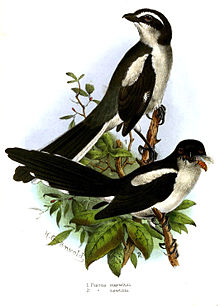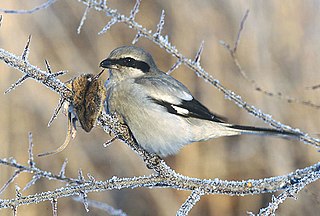
The great grey shrike is a large and predatory songbird species in the shrike family (Laniidae). It forms a superspecies with its parapatric southern relatives, the Iberian grey shrike, the Chinese grey shrike and the American loggerhead shrike. Males and females are similar in plumage, pearly grey above with a black eye-mask and white underparts.

The lesser grey shrike is a member of the shrike family Laniidae. It breeds in South and Central Europe and western Asia in the summer and migrates to winter quarters in southern Africa in the early autumn, returning in spring. It is a scarce vagrant to western Europe, including Great Britain, usually as a spring or autumn erratic.

The northern shrike is a large songbird species in the shrike family (Laniidae) native to North America and Siberia. Long considered a subspecies of the great grey shrike, it was classified as a distinct species in 2017. Six subspecies are recognised.

The long-tailed shrike or rufous-backed shrike is a member of the bird family Laniidae, the shrikes. They are found widely distributed across Asia and there are variations in plumage across the range. The species ranges across much of Asia, both on the mainland and the eastern archipelagos. The eastern or Himalayan subspecies, L. s. tricolor, is sometimes called the black-headed shrike. Although there are considerable differences in plumage among the subspecies, they all have a long and narrow black tail, have a black mask and forehead, rufous rump and flanks and a small white patch on the shoulder. It is considered to form a superspecies with the grey-backed shrike which breeds on the Tibetan Plateau.

The masked shrike is a species of bird in the shrike family, Laniidae. It breeds in southeastern Europe and at the eastern end of the Mediterranean, with a separate population in eastern Iraq and western Iran. It is migratory, wintering mainly in northeast Africa. Although it is a short-range migrant, vagrants have occurred widely elsewhere, including northern and western Europe. It is the smallest member of its genus, long-tailed and with a hooked bill. The male has mainly black upperparts, with white on its crown, forehead and supercilium and large white patches on the shoulders and wings. The throat, neck sides and underparts are white, with orange flanks and breast. The female is a duller version of the male, with brownish black upperparts and a grey or buff tone to the shoulders and underparts. The juvenile has grey-brown upperparts with a paler forehead and barring from the head to rump, barred off-white underparts and brown wings аpart from the white primary patches. The species' calls are short and grating, but the song has melodic warbler-like components.

The African paradise flycatcher is a medium-sized passerine bird. The two central tail feathers of the male are extended into streamers that commonly are more than twice as long as the body. The female tail feathers are of moderate length and without streamers. The upper parts of the male body, wings, and tail are boldly coloured in chestnut or rusty shades, but the underparts and the head are variably grey to blue-gray, with the head of the mature male being darker, commonly glossy black with greenish highlights. The beak and other bare areas, including a wattle ring round the eye, match the colour of the surrounding feathers. The female coloration is similar, though not so showy and glossy and with the head paler.

The tiger shrike or thick-billed shrike is a small passerine bird which belongs to the genus Lanius in the shrike family, Laniidae. It is found in wooded habitats across eastern Asia. It is a shy, often solitary bird which is less conspicuous than most other shrikes. Like other shrikes it is predatory, feeding on small animals. Its nest is built in a tree and three to six eggs are laid.

The southern fiscal, common fiscal or fiscal shrike is a member of the shrike family found through most of Sub-Saharan Africa. It is also sometimes named jackie hangman or butcher bird due to its habit of impaling its prey on acacia thorns to store the food for later consumption. It was previously lumped together with the northern fiscal. Together they were known as the common fiscal.
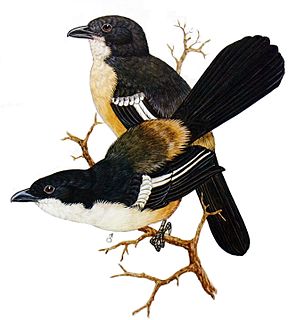
The southern boubou is a bushshrike. Though these passerine birds and their relations were once included with true shrikes in the Laniidae, they are not closely related to that family.
The lesser seedcracker or Nyasa seedcracker is a fairly common species of estrildid finch found in eastern Africa. It has an estimated global extent of occurrence of 925,000 km2 (357,000 sq mi) and is found in Malawi, Mozambique, Tanzania and Zimbabwe. The International Union for Conservation of Nature has classified the species as being of least concern.

The Taita fiscal or Teita fiscal is a member of the shrike family found in east Africa from southeastern South Sudan, southern Ethiopia, and western Somalia to northeastern Tanzania. Its habitat is dry open thornbush and acacia and other dry open woodland.
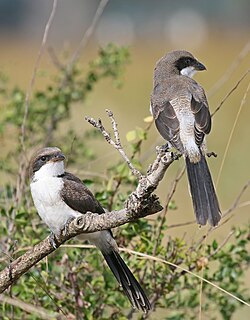
The long-tailed fiscal is a species of bird in the shrike family Laniidae. The species is closely related to the more widespread grey-backed fiscal and is sometimes placed in a separate subgenus, Neolanius, with that species. It is found in southern Somalia, southern and south-eastern Kenya, from the shores of Lake Victoria to the coast; and northern and eastern Tanzania south to Dar es Salaam, with a separate population at Usanga Flats. Its natural habitat is open dry habitats such as dry, treeless savanna, open woodland and cultivated patches.

The grey-backed fiscal is a species of bird in the family Laniidae. It is found in Burundi, Cameroon, Central African Republic, Chad, Democratic Republic of the Congo, Ethiopia, Kenya, Mali, Mauritania, Nigeria, Rwanda, Sudan, Tanzania, and Uganda. Its natural habitats are dry savanna and subtropical or tropical dry lowland grassland.

Mackinnon's shrike, also called Mackinnon's fiscal, is a songbird species of the family Laniidae. Its natural habitats are subtropical or tropical moist montane forests and moist savanna. It is not considered a threatened species by the IUCN.The population of this species is increasing, which is thought to be due to the degradation of nearby habitat. Its common name and Latin binomial commemorate Archibald Donald MacKinnon.

The São Tomé fiscal, or Newton's fiscal, is a species of bird in the family Laniidae. It is endemic to São Tomé Island, São Tomé and Príncipe. It is 20 to 21 centimeters long. The bird is black above with a white shoulder-scapular bar. The São Tomé fiscal has a pale yellow chin, breast, belly, flanks vent and under tail. Its graduated tail has all black central tail feathers and an increasing amount of white on outer web from inner to outer tail feathers. The Lanius newtoni has a clear voice with a whistle tiuh tiuh often repeated and metallic tsink tsink audible over a long distance.
The mountain shrike or grey-capped shrike, is a species of bird in the family Laniidae. It is endemic to the Philippines.

The Abyssinian wheatear, or Abyssinian black wheatear, is a species of bird in the family Muscicapidae. It is found from Ethiopia to southern Kenya and northeastern Tanzania.

The northern fiscal is a member of the shrike family found through most of Sub-Saharan Africa. It used to be grouped with the southern fiscal. Together they were called the common fiscal. The fiscal gets its English and Afrikaans common names from its black and white 'suit-and-tie' appearance reminiscent of the taxman (‘fiscal’).
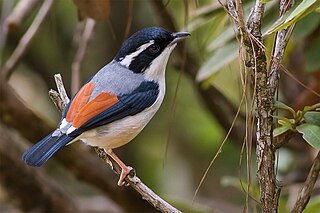
The Himalayan shrike-babbler is a bird species found in the western Himalayas that belongs to the shrike-babbler group. The genus was once considered to be an aberrant Old World babbler and placed in the family Timaliidae until molecular phylogenetic studies showed them to be closely related to the vireos of the New World, leading to their addition in the family Vireonidae. Males and females have distinctive plumages, with the males being all black about with a cinnamon-rufous tertial patch and a distinctive white stripe running from behind the eye. The underside is whitish with some pinkish buff on the flanks. Females have a greyish head, lack the white stripe and have the upperparts and wings with greens, yellow and chestnut. The species is part of a cryptic species complex that was earlier considered as one species, white-browed shrike-babbler with several subspecies.
